Economics 4139 Study guides, Class notes & Summaries
Looking for the best study guides, study notes and summaries about Economics 4139? On this page you'll find 5 study documents about Economics 4139.
All 5 results
Sort by
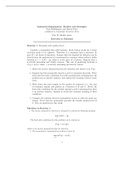
-
Exercises and solutions - Part II|Industrial Organization: Markets and Strategies
- Exam (elaborations) • 27 pages • 2022
-
- $10.49
- 1x sold
- + learn more
Industrial Organization: Markets and Strategies Exercises & Solutions Exercise 1 Monopoly with quality choice Consider a monopolist who sells batteries. Each battery works for h hours and then needs to be replaced. Therefore, if a consumer buys q batteries, he gets H = qh hours of operation. Assume that the demand for batteries can be derived from the preferences of a representative consumer whose indirect utility function is v = u(H) pq, where p is the price of a battery. Suppose that u ...
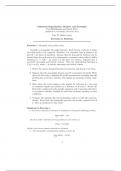
-
Industrial Organization: Markets and Strategies Paul Belleáamme and Martin Peitz published by Cambridge University Press Part II. Market power Exercises & Solutions
- Other • 27 pages • 2023
- Available in package deal
-
- $10.49
- + learn more
Consider a monopolist who sells batteries. Each battery works for h hours and then needs to be replaced. Therefore, if a consumer buys q batteries, he gets H = qh hours of operation. Assume that the demand for batteries can be derived from the preferences of a representative consumer whose indirect utility function is v = u(H) pq, where p is the price of a battery. Suppose that u is strictly increasing and strictly concave. The cost of producing batteries is C(q) = qc(h), where c is stric...
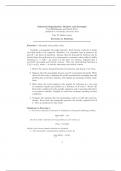
-
Industrial Organization: Markets and Strategies Paul Belleáamme and Martin Peitz published by Cambridge University Press Part II. Market power Exercises & Solutions
- Other • 27 pages • 2023
- Available in package deal
-
- $14.49
- + learn more
Exercise 1 Monopoly with quality choice Consider a monopolist who sells batteries. Each battery works for h hours and then needs to be replaced. Therefore, if a consumer buys q batteries, he gets H = qh hours of operation. Assume that the demand for batteries can be derived from the preferences of a representative consumer whose indirect utility function is v = u(H) pq, where p is the price of a battery. Suppose that u is strictly increasing and strictly concave. The cost of producing bat...
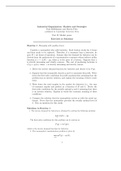
-
Exercises and solutions - Part II Industrial Organization: Markets and Strategies
- Exam (elaborations) • 27 pages • 2022
-
- $10.49
- + learn more
Part II. Market power Exercises & Solutions Exercise 1 Monopoly with quality choice Consider a monopolist who sells batteries. Each battery works for h hours and then needs to be replaced. Therefore, if a consumer buys q batteries, he gets H = qh hours of operation. Assume that the demand for batteries can be derived from the preferences of a representative consumer whose indirect utility function is v = u(H) pq, where p is the price of a battery. Suppose that u is strictly increasing a...
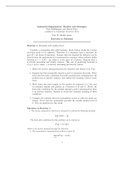
-
Industrial Organization: Markets and Strategies Paul Belleáamme and Martin Peitz published by Cambridge University Press Part II. Market power
- Exam (elaborations) • 27 pages • 2022
-
- $11.49
- + learn more
Consider a monopolist who sells batteries. Each battery works for h hours and then needs to be replaced. Therefore, if a consumer buys q batteries, he gets H = qh hours of operation. Assume that the demand for batteries can be derived from the preferences of a representative consumer whose indirect utility function is v = u(H) pq, where p is the price of a battery. Suppose that u is strictly increasing and strictly concave. The cost of producing batteries is C(q) = qc(h), where c is stric...

How much did you already spend on Stuvia? Imagine there are plenty more of you out there paying for study notes, but this time YOU are the seller. Ka-ching! Discover all about earning on Stuvia


